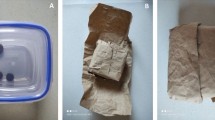Abstract
Cats were initially trained to make operant conditioned food responses to light by an “active selection of reinforcement” method. Provision of low-quality (a mixture of meat and brread) or high-quality (meat) reinforcement depended on the animal pressing a pedal in response to switching on a light with a short (1 sec) or long (10 sec) delay. Some animals responded to long delays— group I, animals with “self control,” while others responded with short delays— group II, “impulsive” animals. Implanted semimicroelectrodes were used in chronic experiments to record multineuron activity in the basolateral amygdala. Cross-correlation analysis was used to study interneuron interactions in the spike discharges of individual neurons, extracted from multineuron activity. The numbers of interneuron interactions were significantly higher in “impulsive” cats of group II in all behavioral situations than in animals with “self control,” and were dominated in “impulsive” animals by the shortest connections, with latencies of 0–30 msec. The largest numbers of connections in both groups were seen on omission of the conditioned pedal-pressing movement response, i.e., when the reinforcement selection task was more difficult. These data indicate that the basolateral amygdala should be regarded as a structure determining the individual typological characteristics of the animals’ behavior.
Similar content being viewed by others
References
O. S. Adrianov, “The organized brain (essay on the principles of construction of the functional organization of the brain). Communication II,” Usp. Fiziol. Nauk.,45, No. 2, 335 (1995).
P. V. Bukh-Viner, I. V. Volkov, and G. Kh. Merzhanova, “A spike collector,” Zh. Vyssh. Nerv. Deyat.40, No. 6, 1194 (1990).
A. I. Venchikov and V. A. Venchikov, Basic Approaches to the Statistical Processing of Observational Results in Physiology [in Russian], Meditsina, Moscow (1974).
U. G. Gasanov, Systems Activity of Cortical Neurons during Learning [in Russian], Nauka, Moscow (1981).
U. G. Gasanov, The Cognitive Function of Cortical Neuronal Networks [in Russian], Nauka, Moscow (1992).
É. E. Dolbakyan, G. Kh. Merzhanova, and I. N. Tveritskaya, “Studies of cortical multineuron activity in dogs with a defensive operant conditioned reflex,” Zh. Vyssh. Nerv. Deyat.,39, No. 5, 898 (1989).
É. E. Dolbakyan, T. A. Tarakanova, and M. A. Fadeeva, “Interneuron functional connections in the sensorimotor cortex in the dog,” Zh. Vyssh. Nerv. Deyat.,44, No. 1, 112 (1994).
G. Kh. Merzhanova, “Time organization of interneuron relationships in the cerebral cortex of the cat related to levels of food motivation,” Zh. Vyssh. Nerv. Deyat.,36 No. 3, 520 (1986).
G. Kh. Merzhanova and A. I. Berg, “Selection of reinforcement quality depending on the delay time of operant responses in cats,” Zh. Vyssh. Nerv. Deyat.,41, No. 5, 948 (1991).
G. Kh. Merzhanova and A. I. Berg, “Cortical-hypothalamic interneuron correlations during learning in cats,” Zh. Vyssh. Nerv. Deyat.,38, No. 6, 1017 (1988).
G. Kh. Merzhanova, A. I. Berg, and Yu. L. Martinson, “Frontal-hypothalamic interactions in cats during performance of free selection of reinforcement,” Zh. Vyssh. Nerv. Deyat.,43, No. 3, 487 (1993).
G. Kh. Merzhanova and A. I. Berg, “Frontal-motor interneuron interactions in cats during performance of free selection of reinforcement,” Zh. Vyssh. Nerv. Deyat.,44, No. 6, 954 (1994).
G. Kh. Merzhanova and É. E. Dolbakyan, “The time organization of interneuron frontal-motor interactions in the cat neocortex depending on the level of food motivation,” Zh. Vyssh. Nerv. Deyat.,46, No. 3, 513 (1996).
M. Mishkin and T. Eppenzeller, “The anatomy of memory,” Scientific American [Russian translation], Mir, Moscow (1987), p. 30.
P. V. Simonov, The Emotional Brain [in Russian], Nauka, Moscow (1981).
S. A. Chepurnov and N. E. Chepurnova, The Amygdaloid Complex of the Brain [in Russian], Moscow State University Press, Moscow (1981).
P. A. Kirkwood, “On the use and interpretation of cross-correlational measurements in the mammalian central nervous system,” J. Neurosci. Meth.,1, 109 (1979).
J. F. LeDoux, “Brain mechanisms of emotion and learning,” Current Opin. Neurobiol.,2, 191 (1992).
J. P. Moore, I. P. Segundo, G. H. Perkel, and H. Levitan, “Statistical signs of synaptic interaction in neurons,” J. Biophys.,10, 876 (1970).
H. Nishijo and T. Ono, “Food memory: neuronal involvement in food recognition,” Asia Pacific J. Clin. Nutr.,1, 3 (1992).
M. Ohno, T. Yamamoto, and S. Watanabe, “Involvements of cholinergic mechanisms in impairment of working memory in rats following basolateral amygdaloid lesions,” Neuropharmacology,31, 915 (1992).
T. Ono, “Amydgalar role in emotion and learning,” in: Proceedings of the Fourth IBRO Congress of Neuroscience, July 9–14, 1995, Kyoto, Japan, IBRO Abstract, Oxford-New York (1995), S42, pp. 63.
T. Oyoshi, H. Nishijo, T. Asakura, et al., “Emotional and behavior correlates of mediodorsal thalamic neurons during associative learning in rats,” J. Neurosci.,16, 5812 (1996).
F. Reinoso-Suarez, Topographischer Hirnatlas der Katze (Für Experimental-Physiologische Untersuchungen), Darmstadt (1961).
R. Tarnecki, “Functional connections between neurons of interpositus nucleus of the cerebellum and the red nucleus,” Behav. Brain Res.,2, 117 (1988).
Additional information
Institute of Higher Nervous Activity and Neurophysiology, Russian Academy of Sciences, Moscow. Translated from Zhurnal Vysshei Nervnoi Deyatel’nosti imeni I. P. Pavlova, Vol. 47, No. 3, pp. 500–506, May–June, 1997.
Rights and permissions
About this article
Cite this article
Merzhanova, G.K., Dolbakyan, É.E. & Partev, A.Z. Interneuron relationships in the basolateral amygdala in cats treated to select food on the basis of quality. Neurosci Behav Physiol 28, 533–538 (1998). https://doi.org/10.1007/BF02463014
Received:
Revised:
Issue Date:
DOI: https://doi.org/10.1007/BF02463014



